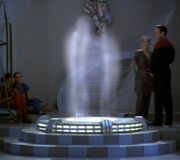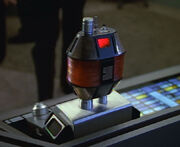
The trajector in use

The trajector matrix
The spatial trajector was a technology utilized by the Sikarians, a species native to the Delta Quadrant, which allowed them to transport to planets up to forty thousand light years away. Operating on the principle of folding space, the trajector utilized antineutrinos as a catalyst for the space-folding process. It then created a neutrino envelope around the object or person to be transported, and used Sikaris' mantle of tetrahedral quartz to focus and amplify the trajector field. This limitation meant that the trajector could only be used on or near the planet itself.
In 2371, the crew of the USS Voyager attempted to negotiate for the technology, but were refused access by the planet's leaders. Subsequently, a small number of crewmembers attempted to covertly obtain the technology by making a deal with a Sikarian trader, exchanging the Federation library for the trajector matrix. When the matrix was activated, it initiated an antineutrino bombardment which destabilized Voyager's plasma manifold and nearly caused a warp core breach. This incident revealed the catastrophic incompatibility of the two technologies and necessitated the physical destruction of the trajector matrix. (VOY: "Prime Factors")

A Borg spatial trajector
By the 2380s, the Borg had assimilated a number of Sikarians and adapted the trajector technology so that it no longer required proximity to Sikaris to function. A trajector was installed in the queencell on Borg cubes, reserved for use by the queen in the event of an emergency.
The Artifact had a trajector, which Hugh hid from his Romulan hosts. In 2399, he used the trajector to send Jean-Luc Picard and Soji Asha to safety on Nepenthe. (PIC: "The Impossible Box")
